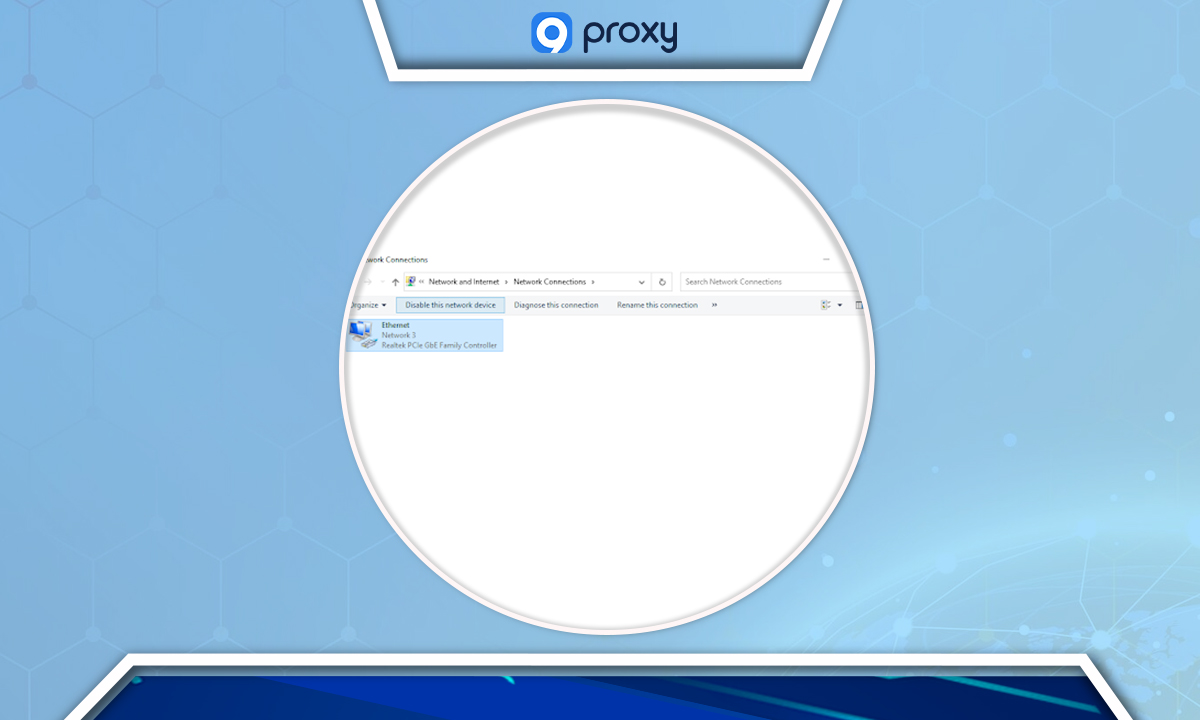How to Fix “Windows Could Not Detect Proxy Settings”
Experiencing the "Windows Could Not Automatically Detect This Network’s Proxy Settings" error can be a significant hurdle in your daily internet use. At 9Proxy, we understand the intricacies of this issue and have compiled a blog that breaks down the problem into manageable steps. Our guide is designed to arm you with the knowledge and tools needed to tackle this challenge head-on, ensuring a smooth and uninterrupted online journey.
Causes of The "Windows Could Not Automatically Detect This Network’s Proxy Settings" Error
The "Windows Could Not Automatically Detect This Network’s Proxy Settings" error message is a common issue that can arise due to several factors. This guide explains these causes in simple terms and provides context for both beginners and experienced users.

- Change in Proxy Settings: This error often occurs when there's a modification in the proxy settings of your Windows operating system. Proxy settings are like a gateway between your computer and the internet, and any changes here can disrupt this connection. Such alterations could result from system file changes, network setting adjustments, or file corruption. In some cases, these changes might be triggered by malicious software (malware) that infects your computer and alters these settings without your knowledge.
- Outdated or Corrupted Network Drivers: Network drivers are software that enables your computer to communicate with network and wireless card adapters. If these drivers are outdated or have become corrupt, your computer might struggle to maintain a stable connection with network services, leading to this error. Keeping your drivers updated is crucial for ensuring smooth communication between your computer and its network hardware.
- Unstable Internet Connection: An inconsistent or weak internet connection can also lead to this error. When your internet connection is unstable, it interrupts the communication between your computer (client device) and the proxy server, a system that acts as a mediator for your internet requests. Regular interruptions can cause the proxy settings to fail.
- Third-Party Applications: Sometimes, applications installed on your PC, especially those that have the capability to modify internet settings, can cause this error. These could be security software, VPNs (Virtual Private Networks), or other types of programs that interact with your network settings. It's important to monitor such applications, as they can unintentionally interfere with your system's proper functioning.
How to Fix the "Windows Could Not Automatically Detect This Network’s Proxy Settings" Error
Experiencing the "Windows Could Not Automatically Detect This Network’s Proxy Settings" error can be frustrating, but there are several steps you can take to resolve it. This guide outlines simple yet effective methods to troubleshoot and fix the issue.
Restart Your Computer and Router
Begin by restarting both your computer and router. This basic step can sometimes resolve the issue by refreshing your network settings and connections. Restarting your router is also a fundamental step in resolving general network issues.

Review Proxy Settings in Windows
Since this error is linked to proxy settings in Windows, checking these settings is a logical next step. In Windows 10 and 11, you can find these settings under the "Network & Internet" category in your system settings. If you're a home user and don't use a proxy, ensure the "Use a proxy server" option is turned off. If you use a proxy (common in business or educational settings), verify that you have the correct settings, potentially consulting your network administrator.

Reboot the Network Adapter
To address complex connectivity issues in Windows 10, a power-cycle of your network adapter can be an effective solution. This process involves a complete reboot of the adapter, potentially resolving persistent problems. To begin, navigate through the following pathway: Settings > Network & Internet > Status. Once there, click on 'Change adapter options'.

Identify your specific type of connection. For wireless connections, select “Wi-Fi”, and for wired or LAN connections, choose “Ethernet”. Proceed to disable the network device by clicking on “Disable this network device” in the toolbar.

It's advisable to wait approximately 15-30 seconds, giving the adapter ample time to shut down completely. After this interval, reactivate the network adapter by selecting the “Enable this network device” button. This method can often restore connectivity in challenging scenarios.

Turn On Automatic IP and DNS Obtention
It's possible that your PC is using manually set IP and DNS addresses, which can cause connectivity issues if these addresses are no longer valid. To resolve this, switch to automatic IP and DNS acquisition. Here's how to do it:
- Press Windows + R keys to open the Run dialog.
- Type “control” and press Enter to open the Control Panel.

- Ensure the view mode is set to Category. Then, go to Network and Internet > Network and Sharing Center > Change adapter settings.

- Right-click on 'Wi-Fi' for a wireless connection or 'Ethernet' for a wired connection, and choose Properties.

- In the list, select 'Internet Protocol Version 4 (TCP/IPv4)' and click on Properties.

- Choose 'Obtain an IP address automatically' and 'Obtain a DNS server address automatically'.

- Click OK to apply these settings.
By setting your device to automatically obtain IP and DNS information, you can often resolve network complications more efficiently.
Reset Network Configuration via the Command Prompt
Windows Command Prompt offers several tools for network troubleshooting. Run it as an administrator and input commands like:
netsh winsock reset
netsh int ip reset
ipconfig /release
ipconfig /renew
ipconfig /flushdns
These commands refresh your network settings and clear old connection data.

Turn Off VPN, Antivirus, and Firewall Software
Occasionally, your VPN, Firewall, or antivirus software may block your network connection, leading to a “cannot detect network setting” error. This issue could also arise from recent software updates or newly installed applications that have modified your proxy settings.

To pinpoint the source of the problem, consider temporarily deactivating your VPN, antivirus, or firewall software individually to see if it resolves the issue. If the error ceases upon disabling one of these programs, it indicates that the program in question is interfering with your network. In such a case, you'll need to adjust its settings to ensure it doesn't hinder your network connectivity.
Check for Virus
Malware can alter your proxy settings, preventing internet access. Run a scan using a reliable anti-malware tool to detect and remove any malicious software.
Do an SFC Scan
Your internet issues might be due to corrupted system files that have altered your internet settings. Running an SFC (System File Checker) scan is an effective solution for many users. This process checks your system files and replaces any corrupted files with the correct versions stored on your system.
If corrupted files are indeed the cause of your problem, an SFC scan should rectify it. Here's how to perform the scan:
- Press the Windows key to open the Start menu.
- Type "cmd" in the search box and select 'Run as administrator'.

- In the Command Prompt, type SFC /scannow and press Enter.

- Wait for the scan to complete. The results will be displayed once it's finished.
This scan can effectively diagnose and repair issues caused by file corruption, potentially resolving your internet connectivity problems.
Run Network Troubleshooter
Windows has a built-in troubleshooter for network issues. Access it through the "Update & Security" section in Settings (Windows 10) or "System > Troubleshoot > Other troubleshooters" (Windows 11). Run the Network Adapter troubleshooter and follow the prompts.

FAQ
Can I turn off automatically detect proxy settings?
Yes, you can. Go to Settings > Network & Internet > Proxy. Then, under Automatic proxy setup, turn off the "Automatically detect settings" option.
How do I remove automatic proxy configuration script?
Go to your computer's proxy settings, found under the System section. In Windows 10, under Automatic proxy setup, turn off "Automatically detect settings" and "Use setup script." Also, under Manual proxy setup, ensure "Use a proxy server" is turned off. Don't forget to save your changes.
Why does my proxy settings automatically change?
This could be due to malware or a specific program installed on your computer. To identify the cause, open the Windows Task Manager (Ctrl + Shift + Esc) and monitor for any suspicious applications that might be altering these settings.
Conclusion
Wrapping up, addressing the "Windows Could Not Automatically Detect This Network’s Proxy Settings" error is manageable with the right approach. We've explored various effective methods, including tweaking proxy settings, updating drivers, and conducting malware scans. These strategies are intended to streamline your troubleshooting process.
If you've found this guide useful, we invite you to explore more at 9Proxy. Our blog offers a wealth of expert insights and detailed solutions for a range of network issues. Keep an eye on 9Proxy for more helpful tips and strategies to enhance and secure your digital experience.
Get Newsletters About Everything Proxy-Related
